The Power of Symbol-Only Branding
In branding, achieving recognition without a name is the holy grail. Think about the Apple logo, McDonald's golden arches, or Nike's swoosh. These symbols have become so iconic that they speak for themselves, transcending language barriers and cultural differences. This phenomenon is a testament to the power of effective branding and its profound impact on consumer perception.
I've worked with interdisciplinary teams to ensure that the clients' branding efforts are cohesive and impactful. A significant part of this process involves simplifying complex ideas into a single clear and concise concept, requiring a balance of creativity and strategic thinking. The key is to bridge gaps between creative vision and practical execution, ensuring the result resonates with the target audience.
Well-designed logos can elevate a brand. The journey to symbol-only branding is long—for example, Nike's Swoosh was created in 1971 and has remained relatively unchanged. In 1995, Nike began using the Swoosh as a stand-alone symbol without the brand name. For those who don't like math, the brand name has accompanied the Swoosh for 24 years, and for the last 29 years, the Swoosh has been synonymous with Nike without the need for the word "Nike."
Original Nike Swoosh from 1971 (courtesy of Nike.com)
Consistent application across all channels is a must. It doesn't make sense to update or change a logo and only use it on a website while still having the old logo on advertisements—repetition and consistency matter. Aligning the brand story, mission, and values with the logo enhances brand recall: same narrative, different platforms.
When a brand reaches the point where its symbol alone can evoke a powerful emotional response, it's because of the strategic and consistent efforts behind it. Nike's Swoosh embodies movement, speed, and athletic excellence. This didn't happen overnight. Nike's commitment to high-performance products, innovative marketing campaigns, and the celebration of athletic achievement all contributed to the strength and recognition of its logo.
Companies must invest in research, understand their audience, and remain consistent in their messaging and visual identity. It's about creating a symbol that stands out in a congested market by encapsulating the brand's essence. Building a cohesive and powerful brand identity requires thoughtfully laying out blueprints and setting a solid foundation for consistent and impactful brand messaging and visuals.
The power of symbol-only branding lies in its ability to communicate a brand's identity instantly and universally. It's a powerful testament to the impact of thoughtful and consistent branding efforts.
References:
https://www.nike.com/a/never-done-leaving-a-mark-swoosh
https://www.portlanddesignhistory.com/post/carolyn-davidson
